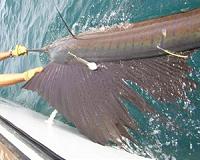| . |  |
. |
Quito, Ecuador (UPI) Jan 4, 2011 Tuna fishing, a major resource for the Ecuadorian economy, has been hit by the vagaries of weather in the Pacific waters believed to have been caused by the La Nina phenomenon, officials said. Tuna yields in the first 10 months of 2010 dropped 16 percent because of disruptions to marine life caused by La Nina, data released by the Association of Tuna Companies from Ecuador indicated. Exports of tuna and other salt water fish are a major source of foreign exchange revenue for Ecuador, an oil producer but still largely impoverished. More than 35 percent of Ecuador citizens eke out their livelihoods on fisheries or farms. Atunec statistics showed the equatorial country's state-regulated Pacific fishing fleets caught 402,868 tons of tuna from January-October 2010, which was 16 percent less than the 478,633 tons landed in the same period in 2009. Officials said the lower yield resulted from adverse weather conditions caused by La Nina, which creates the opposite of weather conditions usually associated with El Nino. Ecuador, Chile and other Pacific Latin American countries experienced both La Nina and El Nino episodes in the past, sometimes with devastating results. Scientists warned a new La Nina episode now in progress could last through the first several months of 2011. Business sources said the weather could greatly diminish Ecuador's earnings from tuna exports, estimated to be 70 percent of the country's foreign exchange earnings. During the first 10 months of 2010, Ecuador's tuna exports fell both in volume and value compared to the previous year, the Central Bank of Ecuador said. During last year, Ecuador exported nearly 125,000 tons of fresh, frozen and preserved tuna with a value of $472.9 million. This compared unfavorably with the 2009 statistics, when Ecuador exported 134,000 tons and earned $525.7 million. The outlook for Ecuador's tuna output in the coming year remains uncertain, mainly because of La Nina, analysts said. Strong La Nina episodes occurred during 1988-89. La Nina also caused damage in 1995 and again in 1999-2000. A minor La Nina episode affected the region in 2000 and 2001. A stronger La Nina phase developed in mid-2007 and went on through early 2009. The U.S. National Oceanic and Atmospheric Administration said that moderate La Nina conditions that developed last year would likely continue at least into spring 2010. The U.S. Climate Prediction Center is among regional environmental forecast services keenly watching developments in the Pacific, including the Ecuador coastline. La Nina effects cannot always be predictable. The flood in Pakistan last year was seen by scientists as a direct result of La Nina.
Share This Article With Planet Earth
Related Links Water News - Science, Technology and Politics
 Growing Hypoxic Zones Reduce Habitat For Billfish And Tuna
Growing Hypoxic Zones Reduce Habitat For Billfish And TunaWashington DC (SPX) Dec 31, 2010 Billfish and tuna, important commercial and recreational fish species, may be more vulnerable to fishing pressure because of shrinking habitat, according to a new study published by scientists from NOAA, The Billfish Foundation, and University of Miami Rosenstiel School of Marine and Atmospheric Science. An expanding zone of low oxygen, known as a hypoxic zone, in the Atlantic Ocean is enc ... read more |
|
| The content herein, unless otherwise known to be public domain, are Copyright 1995-2010 - SpaceDaily. AFP and UPI Wire Stories are copyright Agence France-Presse and United Press International. ESA Portal Reports are copyright European Space Agency. All NASA sourced material is public domain. Additional copyrights may apply in whole or part to other bona fide parties. Advertising does not imply endorsement,agreement or approval of any opinions, statements or information provided by SpaceDaily on any Web page published or hosted by SpaceDaily. Privacy Statement |